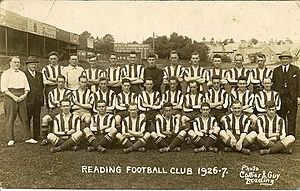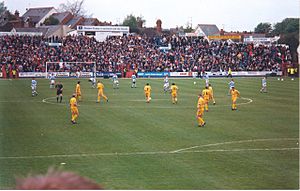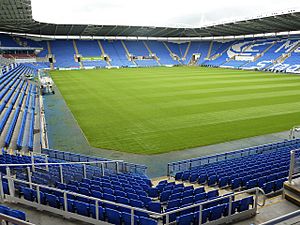Reading F.C. facts for kids
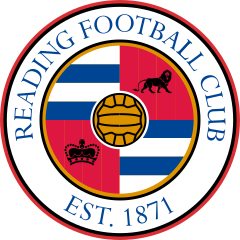 |
||
| Full name | Reading Football Club | |
|---|---|---|
| Nickname(s) | The Royals The Ding The Biscuitmen (historic) |
|
| Founded | 25 December 1871 | |
| Ground | Select Car Leasing Stadium | |
| Capacity | 24,161 | |
| Owner | Redwood Holdings Limited | |
| Chairman | Rob Couhig | |
| Manager | Noel Hunt | |
| League | Championship | |
| 2018–19 | Championship, 20th of 24 | |
|
|
||
Reading Football Club is a professional football team from Reading, Berkshire, England. They are known as The Royals because of Berkshire's royal connections. They also used to be called The Biscuitmen because of the famous biscuit factory, Huntley & Palmers, in the town.
The club was started in 1871, making it one of England's oldest football teams. Reading joined The Football League in 1920. They first played in the top league of English football in the 2006–07 season. They even won the Championship in the 2011–12 season. This meant they played in the 2012–13 Premier League but were relegated after one season.
Reading won the 1987–88 Full Members' Cup by beating Luton Town 4–1 at Wembley. Their best performance in the FA Cup was reaching the semi-finals twice. This happened in 1926–27 and again in 2014–15.
The team played at Elm Park for 102 years, from 1896 to 1998. In 1998, they moved to the Madejski Stadium, named after former chairman Sir John Madejski. In 2021, the stadium was renamed the Select Car Leasing Stadium for sponsorship reasons.
Reading holds a record for winning 13 league games in a row at the start of the 1985–86 season. In the 2005–06 Football League Championship season, they set a record for the most points in a professional league season with 106 points. Their highest finish in the 2006–07 Premier League was eighth place.
Contents
Club History
Early Years and Growth (1871–1991)
Reading Football Club was formed on 25 December 1871. Joseph Edward Sydenham organized a public meeting to start the club. Early games were played at various local grounds. In 1895, the club became professional. This meant they needed a bigger home.
They moved to a special stadium called Elm Park on 5 September 1896. In 1913, Reading went on a successful tour of Italy. An Italian sports newspaper called them "the finest foreign team seen in Italy."
Reading joined the Football League Third Division South in 1920. They were promoted to the Second Division in 1926. Their best FA Cup run happened in 1926–27. They reached the semi-finals but lost to Cardiff City. The biggest crowd at Elm Park was 33,042 people for a match against Brentford. This is still the highest attendance for a Reading home game.
Reading was relegated to the fourth tier of English football in the 1971–72 season. They won the Fourth Division in the 1978–79 season to get promoted back to the Third Division.
In 1983, there was a plan to merge Reading with Oxford United. This new team would be called "Thames Valley Royals." However, Reading fans and directors fought against this idea. They managed to stop the merger, keeping Reading Football Club independent.
In 1988, Reading won the Simod Cup. They beat several top teams on their way to the final at Wembley. They were promoted to the Second Division in 1986 but were relegated back to the Third Division in 1988.
New Stadium and Premier League Dreams (1991–2013)
John Madejski took over the club in 1991. Under his leadership, Reading started to improve. They won the new Division Two title in 1994. In 1995, they almost reached the Premier League. They lost 4–3 to Bolton Wanderers in the play-off final, even after being 2–0 up.
In 1998, Reading moved to their new home, the 24,200-seat Madejski Stadium. This stadium was named after chairman John Madejski. The club finished third in 2000–01 and reached the play-off final but lost to Walsall. They were promoted to Division One in 2002–03. The next season, they finished fourth and made the play-offs again.
Reading had an amazing season in 2005–06. They won the Championship with a record 106 points. They scored 99 goals and only lost twice. This meant they were promoted to the top division of English football for the first time ever.
In their first Premier League season, 2006–07, Reading surprised everyone. They finished in eighth place, which was a great achievement. However, they were relegated back to the Championship after their second season in the Premier League.
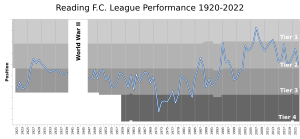
In the 2011–12 season, Reading had a strong second half of the season. They won promotion back to the Premier League on 17 April 2012. This was after a 1–0 home win against Nottingham Forest.
In May 2012, John Madejski sold a majority share of the club. This ended his long ownership. Reading won their first Premier League game of the 2012–13 season in November 2012. However, they were relegated again at the end of that season.
Challenges and Changes (2013–Present)
After returning to the Championship, Reading aimed for another quick return to the Premier League. They signed some well-known players. However, they missed out on the play-offs in the 2013–14 season due to a last-minute goal by Brighton.
The club faced financial difficulties in the 2014–15 season. A Thai group took over the club. Despite league struggles, Reading had a great FA Cup run. They reached the semi-finals again, losing to Arsenal at Wembley.
In 2017, Chinese investors Dai Yongge and Dai Xiu Li bought the club. Under manager Jaap Stam, Reading finished third in the Championship in the 2016–17 season. They reached the play-off final at Wembley but lost on penalties to Huddersfield Town.
The team struggled in the 2017–18 season and avoided relegation by only three points. Managers changed several times in the following years. In November 2021, Reading was deducted six points by the EFL. This was because they broke rules about how much money they could lose. They had lost £146 million over five years, which was much more than allowed.
In March 2023, the team faced another six-point deduction for financial rule breaches. The club accepted this penalty in April 2023. This deduction meant Reading was relegated from the Championship on 4 May 2023. Without the points deduction, they would have stayed in the league.
In June 2023, Reading faced more charges for not paying players and taxes on time. This led to another points deduction at the start of the 2023–24 League One season. Fans started a campaign called "Sell Before We Dai," urging owner Dai Yongge to sell the club. More points deductions followed in August and September 2023. In January 2024, a match was stopped because fans protested the owner. In February 2024, two more points were deducted.
In May 2025, Redwood Holdings Limited completed its takeover of the club. This brought new ownership to Reading Football Club.
Club Crest and Colours
Reading's first crest was the Reading Coat of Arms. The first crest on a kit was just the letter "R" in 1953. Later crests included elm trees and rivers. The current crest was introduced in the 1998–99 season. It uses the club's blue and white colours. It also features a crown for the Royal County of Berkshire and the Maiwand Lion to represent Reading.
In the 2022–23 season, the home kit sleeves had a special stripe design. These stripes showed average temperatures since the club's founding. This was to raise awareness about climate change. The shirts were also made from recycled plastic bottles.
Stadiums and Training
Reading played at several grounds in its early days. These included Reading Recreation Ground and Elm Park.
Elm Park became Reading's home in 1896. It was built on a former gravel pit. The first game there had about 2,500 fans.
In 1994, new rules meant that clubs in the top two divisions needed all-seater stadiums. Elm Park could not be easily changed. So, a new stadium was planned in Smallmead. The new Madejski Stadium opened on 22 August 1998. It cost over £50 million to build.
When Reading reached the Premier League in 2006–07, they planned to expand the stadium. Permission was given to increase capacity to 36,900 seats. In 2016, the North Stand was renamed the Eamonn Dolan Stand. This was in honour of a former academy manager.
In July 2021, the Madejski Stadium was rebranded as the Select Car Leasing Stadium. This was for a ten-year sponsorship deal. The East Stand was renamed the Sir John Madejski Stand.
In March 2024, the club's owner sold the Bearwood Park training ground. This was done to help fund the club's short-term future.
Club Support
Reading has a strong fan base. The Reading Football Supporters’ Club (RFSC) was formed in 1930. It helped raise money for the club. In 2002, the Supporters' Trust at Reading took over this role.
In 2001, Reading became the first club to register their fans as an official squad member. The "player" was given squad number 13 and named 'Reading Fans'.
For the 2015–16 season, Reading had almost 13,000 season ticket holders. The average attendance for that season was 17,570.
Rivalries
Reading's biggest rivals used to be Aldershot. There were strong feelings between the fans. Since Aldershot went out of business, Reading's main local rivals are Oxford United and Swindon Town. When these three teams were in the same division, their rivalry was called the "Didcot Triangle."
Club Records and Statistics
Key Records
- Highest League Finish: 8th in the Premier League, 2006–07.
- Best FA Cup Performance: Semi-finals, 1926–27 and 2014–15.
- Biggest Win: 9–0 against Exeter City (19 September 2023, EFL Trophy).
- Heaviest Defeat: 18–0 against Preston North End (27 January 1894, FA Cup).
- Longest Winning Start to a Season: 13 victories in 1985–86.
- Most Points in a Season: 106 points in 2005–06.
- Fastest Goal (Club Record): 9.55 seconds by Yakou Méïté (2020–21).
Most Appearances
The player with the most appearances for Reading is Martin Hicks, who played 603 games between 1978 and 1991.
| Pos. | Player | Appearances |
|---|---|---|
| 1 | 603 | |
| 2 | 537 | |
| 3 | 505 | |
| 4 | 487 | |
| 5 | 481 |
Top Goalscorers
The player with the most goals for Reading is Trevor Senior, who scored 191 goals between 1983 and 1992.
| Pos. | Player | Goals |
|---|---|---|
| 1 | 191 | |
| 2 | 168 | |
| 3 | 167 | |
| 4 | 104 | |
| 5 | 103 |
Goalkeeping Records
Steve Death holds the record for the longest time without letting in a goal. He went 1,103 minutes without conceding in the 1978–79 season.
Other Notable Records
Reading holds the record for the most points in a professional league season with 106 points in 2005–06. The highest attendance at Elm Park was 33,042 in 1927. The highest attendance at the Madejski Stadium is 24,184, for a Premier League game against Everton in 2012.
The highest transfer fee Reading has received for a player is £6.6 million for Gylfi Sigurðsson in 2010. Gylfi Sigurðsson was also the first player from the Reading academy to play and score in a FIFA World Cup.
Women's Team
Reading FC Women's team was started in May 2006. They played in the FA Women's Super League 2 and won promotion to the top league, the FA Women's Super League 1, in 2015. Their highest league finish was fourth in the 2017–18 season. The women's team also plays at the Select Car Leasing Stadium.
In 2023, Reading FC Women became a part-time team. On 30 June 2024, the team withdrew from the Women's Championship due to financial problems. They moved down to Tier 5 of the women's football pyramid.
Images for kids
See also
 In Spanish: Reading Football Club para niños
In Spanish: Reading Football Club para niños


